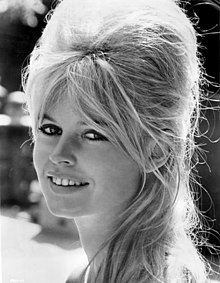The seductive 1950s sex-bomb whose daring backless dresses inspired ‘Jessica Rabbit’
Bombshell (sex symbol)
From Wikipedia, the free encyclopedia
The term bombshell is a forerunner to the term "sex symbol" and originally used to describe popular female sex icons. In modern usage, bombshell refers to a very attractive woman.[1][2] The Online Etymology Dictionary by Douglas Harper attests the usage of the term in this meaning since 1942, and in the meaning of "shattering or devastating thing or event" since 1860.[3]
Contents
[hide]History[edit]
The first woman to be known as a bombshell was Jean Harlow, who was nicknamed the "blonde bombshell" for her 1931 film Platinum Blonde.[4][5][6][7] Two years later she starred in the Metro-Goldwyn-Mayer film Bombshell.[4] One of the blurbs on posters was "Lovely, luscious, exotic Jean Harlow as the Blonde Bombshell of filmdom."[8]
The epithet rose sharply in popularity after the death of Marilyn Monroe in 1962, and declined in popularity in late 1960s due to emerging ideological conflicts.[9]
Hollywood soon took up the blonde bombshell, and then, during the late 1940s through the early 1960s, brunette, exotic, and ethnic versions (e.g., Jane Russell, Dorothy Dandridge, and Sophia Loren) were also cultivated as complements to, or as satellites of, the blonde bombshell.[10]Some of the film stars, largely of 1940s–1960s, referred to as bombshells include Marilyn Monroe, Rita Hayworth, Diana Dors, Jayne Mansfield, Mamie Van Doren, Jane Russell, Ava Gardner, Carroll Baker, Brigitte Bardot, Kim Novak, Sophia Loren, Elizabeth Taylor, Ann-Margret, Veronica Lake, Raquel Welch, and Ursula Andress.[9][11]
Stereotype[edit]
Bombshells are identified with hypersexuality, their curves, including hourglass figures and large breasts, sex appeal, larger than life personas,[9] as well as stereotypes associated with blonde women and supermodels.[9][10][12]




沒有留言:
張貼留言